#movement: sōsaku-hanga
Text

Cat and Girl, c. 1952
Saitō Kiyoshi (1907-1997)
#artist: saitō kiyoshi#era: 20th century#medium: print#medium: woodblock print#medium: paper#medium: ink#movement: sōsaku-hanga#medium: ink and color on paper#nationality: japanese
1 note
·
View note
Text

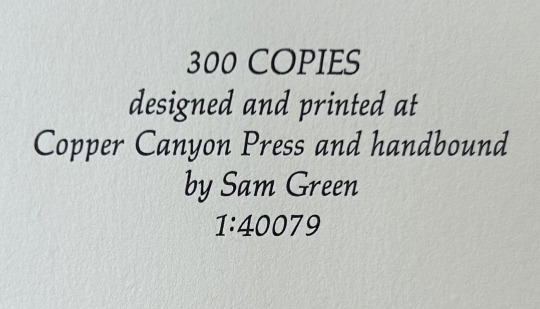
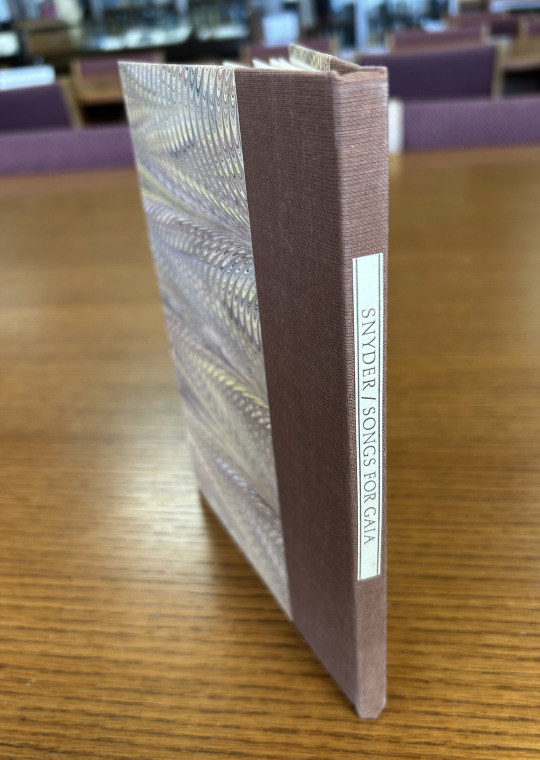







It’s Fine Press Friday!
Today we’re taking a deep dive into Songs for Gaia, a slim edition of poetry by Gary Snyder (b. 1930). This understated, beautifully-crafted letterpress volume was printed in 1979 for Kah Tai Alliance at Copper Canyon in Port Townsend, WA, a fine press dedicated solely to poetry since its founding in 1972, and was handbound by poet and bookbinder Samuel Green. It features woodblock illustrations by poet and printmaker Michael Corr (b. 1940), who learned his craft while living in Kyoto from block printer and illustrator Takeji Asano (1900-1999). Asano was a notable figure in Japan’s Sōsaku-hanga woodblock printing movement. The book is quarter bound in cloth with a cover marbled in a finely executed combed feather pattern, a touch that lends a hint of psychedelia to its otherwise traditional aesthetics. It was released in a limited edition of 300 copies.
Snyder, who is popularly known for his time amongst and spiritualist influence on the Beat poets and the counterculture of their generation (along with Kerouac’s portrayal of him as Japhy Ryder in the 1958 novel The Dharma Bums) spent 13 years in Japan (1956-1968) studying Zen Buddhism, forestry, and ecology. A scholar of Asian languages versed in cultural anthropology, he also studied calligraphy with accomplished calligrapher and seal carver Charles Leong during his time at Reed College. Snyder’s calligraphic signature graces the half-title page of this edition.
This modest yet potent edition of Songs for Gaia is a fitting form for the work of a poet whom writer Bob Steuding once characterized as cultivating an “accessible” style and “a new kind of poetry that is direct, concrete, non-Romantic and ecological.” As Snyder wrote of his own work in A Controversy of Poets, “I try to hold both history and wilderness in mind, that my poems may approach the true measure of things and stand against the unbalance and ignorance of our times.”
View more Fine Press Friday posts
View more woodblock illustration posts
View more marbling posts (shout out to Alice, our resident marbling expert!)
-Ana, Special Collections Graduate Fieldworker
#Fine Press Friday#fine press fridays#marbling#Gary Snyder#poetry#Copper Canyon Press#Songs for Gaia#Samuel Green#Michael Corr#woodblock illustration#woodblock#letterpress#fine press#feather pattern marbling#UWM Special Collections#handbound book#hand binding#Ana
69 notes
·
View notes
Text
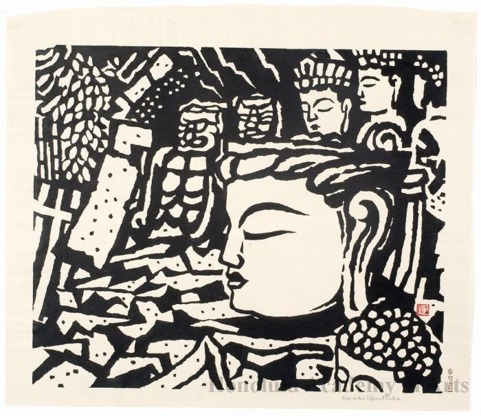
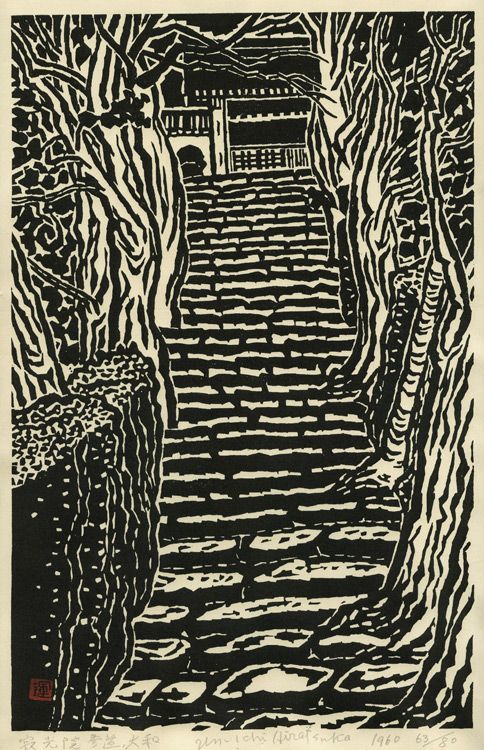


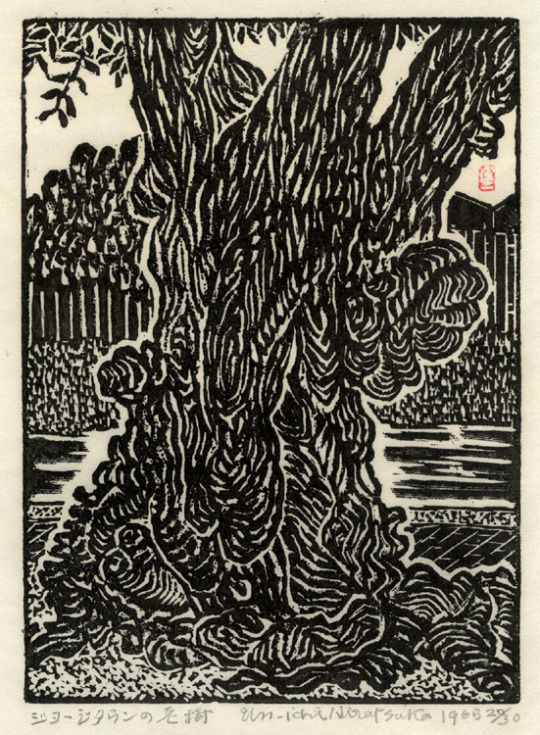
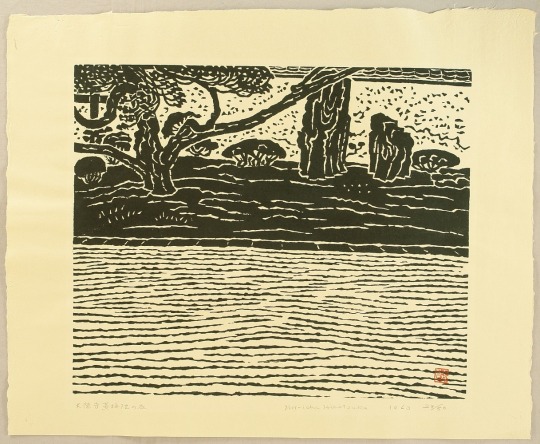
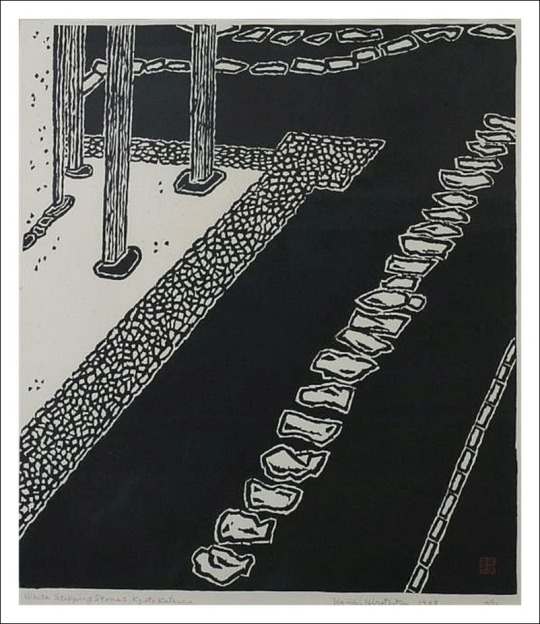
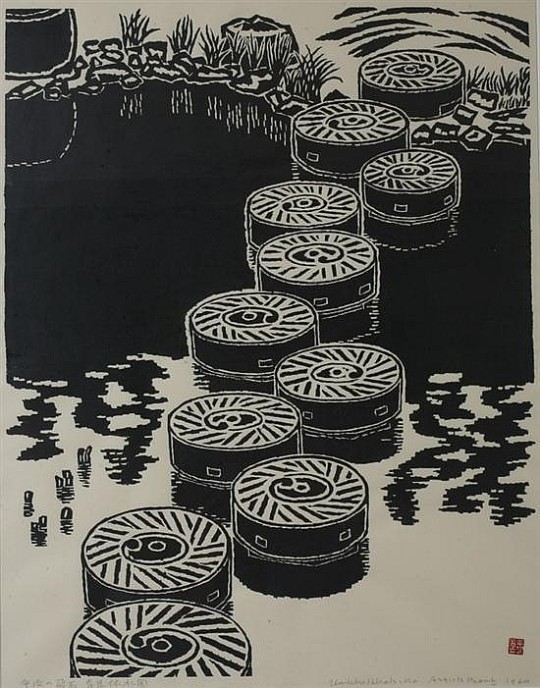
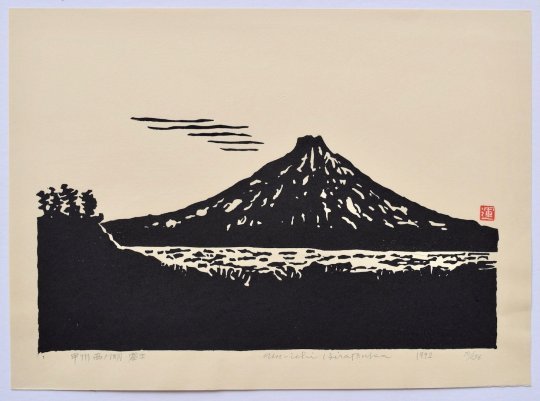
Unichi Hiratsuka (1895–1997), born in Matsue, Shimane, was a Japanese woodblock printmaker. He was one of the prominent leaders of the sōsaku hanga ("creative print") movement in 20th century Japan.
Hiratsuka's father was a shrine carpenter, and his grandfather was an architect who designed houses and temples. Therefore, the artist was introduced to wood-working and architecture early in his life.
Hiratsuka was the best–trained woodcarver in the sōsaku hanga movement. From 1928 onwards he taught the renowned sōsaku hanga artist Shikō Munakata (1903–1975) wood carving. The same year he joined with seven other like-minded artists to work on the 100 Views of New Tokyo series, to which he contributed twelve prints; his prints were lauded for their "technical beauty and perfection."[1] Between 1935 and 1944 Hiratsuka taught the first blockprinting course at the Tokyo School of Fine Arts.
He moved to Washington D.C. in 1962 and spent thirty three years in the United States. While living in Washington DC, he was commissioned by three standing Presidents to carve woodblock prints of National Landmarks, which included the Lincoln Memorial, Washington Monument and Library of Congress which are in the collections of The National Gallery and Freer Gallery today. He ultimately returned to Japan in 1994.
22 notes
·
View notes
Photo

Onchi Kōshirō: Affection for Shapeless Things @artinstitutechi
Onchi Kōshirō is emblematic of the midcentury sōsaku hanga, or creative print, movement in Japan as one of its major artists and its main advocate.
59 notes
·
View notes
Text
"Flowers of All Seasons" (a ca. 1960s-70s woodblock print) by Kasamatsu Shirō (笠松 紫浪; 1898-1991)
"Flowers of All Seasons" (a ca. 1960s-70s woodblock print) by Kasamatsu Shirō (笠松 紫浪; 1898-1991), a prominent member of both the shin-hanga (新版画, new prints) and, later, sōsaku-hanga (創作版画, creative prints) art movements in 20th century Japan.
This charming print presents six of Japan’s iconic seasonal flowers, notably excluding the most famous of them all, the cherry blossom (桜の花 sakura no hana).
The flowers shown, in order, are as follows:1) January & February - Plum Blossoms2) March & April - Camellia3) May & June - Iris 4) July & August - Morning Glory 5) September & October - Broad Bell-Flower6) November & December - Chrysanthemum
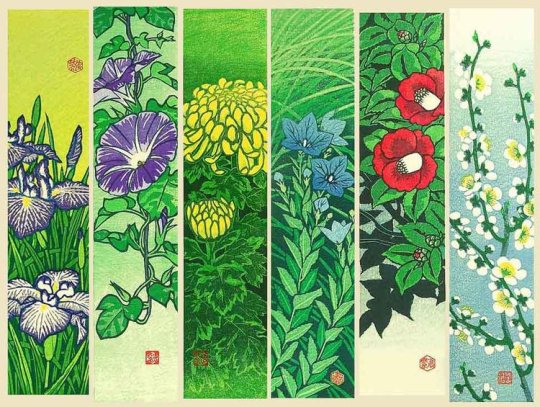
#Kasamatsu Shirō (笠松 紫浪; 1898-1991)#Flowers of All Seasons#Japanese woodblock#Japanese woodblock printmaking#Japanese art#shin-hanga (新版画)#sousaku-hanga (創作版画)#Japan#jadedinjapanworld
7 notes
·
View notes
Text






Kōshirō Onchi - Print/Painting Electives
Kōshirō Onchi was a Japanese printmaker who was born in Tokyo in 1891, and was a pioneer of the 20th century sōsaku-hanga Japanese art movement. This movement was a a contrast to the commercial print-making process of making ukiyo-e woodblocks, in which the artist worked with carvers, printers and publishers to create prints that were highly commercial and easy to reproduce. The new movement of sōsaku-hanga focused on artists creating, carving, printing & publishing their own unique works of high art that incorporated their own individual style and modern printing techniques.
Onchi’s prints are poetic poetic, often abstract, and full of emotion. He used wood-blocks, fabrics, leaves and many other materials to create his prints. I find the way his prints have both abstract and figurative elements to them, and am drawn in by his use of colour and his portraits in particular.
7 notes
·
View notes
Photo

'Autumn' (the Japanese title of this woodblock print is 紅葉の安らぎ (Momiji no Yasuragi), which translates roughly as the "Serenity of Red Maple"), ca. 1980, from the "Birds of the Seasons" series, by Yoshida Tōshi (吉田 遠志, 1911 – 1995), a Japanese printmaking artist associated with the sōsaku-hanga (creative prints) movement.
Tōshi was the fist born son of 20th-century Japanese landscape painter and woodblock printmaker Yoshida Hiroshi (吉田 博, 1876 – 1950), who is regarded as one of the greatest artists of the shin-hanga (new prints) style
11 notes
·
View notes
Photo
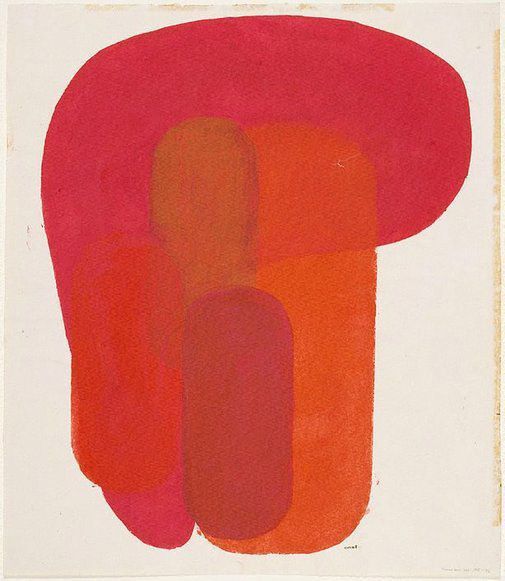
New Post has been published on https://dearart.net/painting/painting-ideas-koshiro-onchi-1891-1955-forme-no-11-paperblock1949-koshiro-onchi-born/
Painting Ideas : Koshiro Onchi (1891-1955) : Forme No. 11, paperblock,1949. Kōshirō Onchi, born...

Painting Ideas :
– Picture :

– Description
Koshiro Onchi (1891-1955) : Forme No. 11, paperblock,1949. Kōshirō Onchi, born in Tokyo, was a Japanese print-maker. He was the father of the sōsaku-hanga movement in twentieth century Japan, and a photographer.
-Read More –
2 notes
·
View notes
Text
shiko munakata
Shikō Munakata was a woodblock printmaker active in Shōwa period Japan. He is associated with the sōsaku-hanga movement and the mingei movement. Munakata was awarded the "Prize of Excellence" at the Second International Print Exhibition in Lugano, Switzerland in 1952, and first prize at the São Paulo Bienal Exhibition in Brazil in 1955, followed by Grand Prix at the Venice Biennale in 1956, and the Order of Culture, the highest honor in the arts by the Japanese government in 1970.

6 notes
·
View notes
Photo



* Zine research * - Shiko Munakata
*Shikō Munakata was a woodblock printmaker active in Shōwa period Japan. He is associated with the sōsaku-hanga movement and the mingei movement* - Munakata is a woodblock print artist, best known for black and white prints and his expression of sketch-like lines. He began his career in oil painting, organising the Seikokai and exhibiting at Hakujitsukai, Bunten and Teiten.
From looking at Munakata’s artwork, I notice that pretty much all of his artwork is in the style of a black silhouette. I think this works really well, as the detailing stands out against the white background, making the main design really clear and bold. For my own work, I have taken inspiration, also using black to create a silhouette image. I wanted to have some opposing colour and create a vibrant background, therefore I have decided to use red and yellow as a contrast against my silhouette. I really like the affect this has created, as the red and yellow give the impression of a sunset and suit my Zine really well. The complexity of Munakata’s designs adds more of a depth - I found it difficult to make sure that I cut deep enough, as some of my lines didn’t come out and give the detailing I wanted. Many of the themes in his art was taken from the traditions of his native Aomori in Northern Japan, including the local people’s love of nature and folk festivals. His belief and philosophy were engrained into Zen Buddhism - which is reflected in his work. His prints feature images of floating nude females to represent Shinto Kami that inhabit trees and plants. This is inspired by the poetry of the Heian period. Poetry and calligraphy is also often incorporated into his prints. I personally really like how calligraphy has been incorporated, as it helps the artwork to look *busy*. The calligraphy stands out to me and could be something to use in my own design work.
My Zine is based on animals and general Japanese culture, therefore including some calligraphy + bold prints would work well as symbolism as they stand out. I think a silhouette is a really good way to create a symbol and think it would especially work well with animals, although I thought the process was quite time consuming.
6 notes
·
View notes
Text
Shiko Munakata
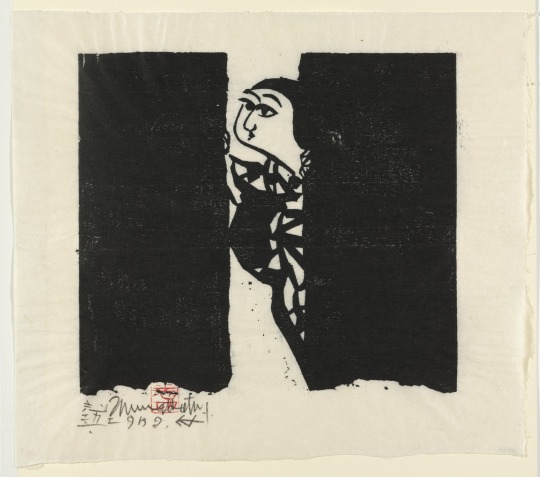

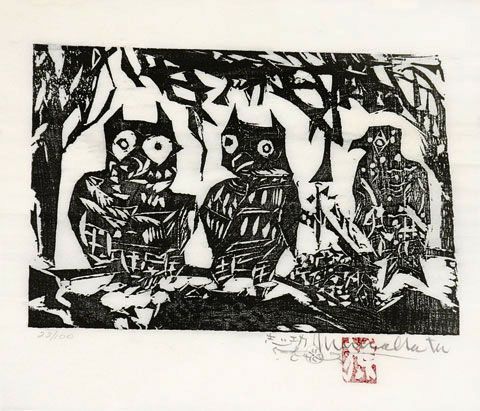

“Shikō Munakata (棟方 志功, Munakata Shikō, September 5, 1903 – September 13, 1975) was a woodblock printmaker active in Shōwa period Japan. He is associated with the sōsaku-hanga movement and the mingei (folk art) movement. Munakata was awarded the "Prize of Excellence" at the Second International Print Exhibition in Lugano, Switzerland in 1952, and first prize at the São Paulo Bienal Exhibition in Brazil in 1955, followed by Grand Prix at the Venice Biennale in 1956, and the Order of Culture, the highest honor in the arts by the Japanese government in 1970.”
Here it is very easy to see that Munakata has a very specific art style that he strictly follows in all of his pieces. He creates woodblock prints which makes total sense why his artstyle is simplified down to its core, but at the same time it’s very much so not impressive to look at. A child that doesn’t know how to draw would probably draw like this and Munakata claimed this bad quality art as his style and now makes big money off of it. I like his colour schemes and how he doesn’t limit himself to specific colours like black and white like some other print artist would probably do to save time and money, I feel that is a good move on his part. I also dont like how he doesn’t aknowledge human anatomy which is like the basics of what you need to do to produce good realistic looking art. It’s easy to see that Munakata instead simply draws how things look instead of how they are, which at his style is not a problem but if he ever were to go realistic it would cause him much trouble.
https://en.wikipedia.org/wiki/Shik%C5%8D_Munakata
4 notes
·
View notes
Text
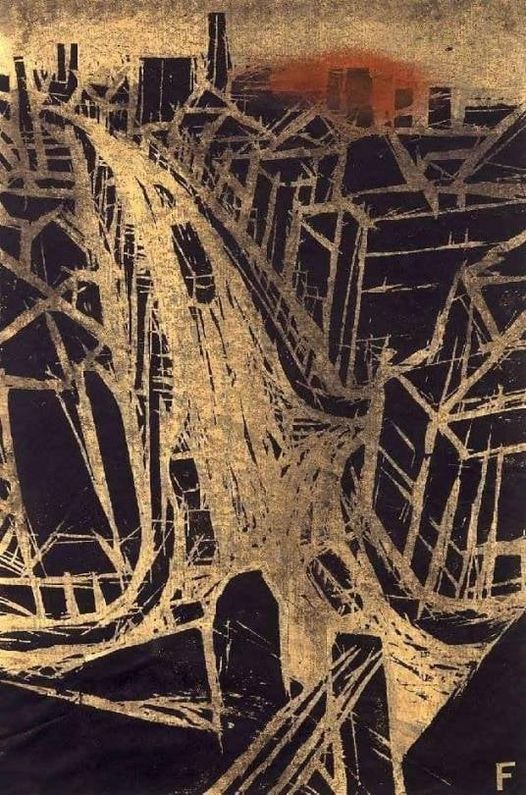
“Red Sun” (1934) by Fujimaki Yoshio (藤牧 義夫; 1911 - 1935), a Japanese woodblock artist active in the early twentieth century as a member of the sōsaku-hanga (創作版画, creative prints) art movement.
21 notes
·
View notes
Photo

Lena Young14 декабря 2018 г. · Mirror, 1930, Koshiro Onchi.
Kōshirō Onchi (1891 – 1955), born in Tokyo, was a Japanese print-maker. He was the father of the sōsaku-hanga movement in twentieth century Japan, and a photographer.
3 notes
·
View notes
Photo


Shiko Munakata was a Japanese print artist active in the Showa period and was highly involved with the sōsaku-hanga and the mingei movement (folk art). He is best known for his black and white prints and his expressive sketch like line style. His style was very unique and famous for winning awards, starting of as an oil painter, Munakata was much more at home with woodblock art. His work is fairly simple and abstract sometimes but still looks good despite it not being my style, its also very interesting to see that succeed details pictures can be made with prints.
0 notes
Text
Hiroshi Yoshida


Hiroshi Yoshida (born Hiroshi Ueda) was born in the city of Kurume, Fukuoka, in Kyushu, on September 19, 1876. He showed an early aptitude for art fostered by his adoptive father, a teacher of painting in the public schools. At age 19 he was sent to Kyoto to study under Tamura Shoryu, a well known teacher of western style painting. He then studied under Koyama Shōtarō, in Tokyo, for another three years. In 1899, Yoshida had his first American exhibition at Detroit Museum of Art. He then traveled to Boston, Washington, D.C., Providence and Europe. In 1920, Yoshida presented his first woodcut at the Watanabe Print Workshop, organized by Watanabe Shōzaburō, publisher and advocate of the shin-hanga movement. However, Yoshida's collaboration with Watanabe was short partly due to Watanabe's shop burning down because of the Great Kanto earthquake on September 1, 1923. In 1925, he hired a group of professional carvers and printers, and established his own studio. Prints were made under his close supervision. Yoshida combined the ukiyo-e collaborative system with the sōsaku-hanga principle of "artist's prints", and formed a third school, separating himself from the shin-hanga and sōsaku-hanga movement. Hiroshi Yoshida was trained in the Western oil painting tradition, which was adopted in Japan during the Meiji period. Yoshida often used the same blocks and varied the colour to suggest different moods. The best example of such is Sailing Boats in 1921. Yoshida's extensive travel and acquaintance with Americans influenced his art considerably. In 1931 a series of prints depicting scenes from India, Pakistan, Afghanistan, and Singapore was published. Six of these were views of the Taj Mahal in different moods and colours.
0 notes
Photo

"Hummingbirds and Fuchsia" (1971) by Yoshida Tōshi (吉田 遠志, 1911-1995), a Japanese printmaking artist associated with the sōsaku-hanga (creative prints) movement, and the first born son of world renowned shin-hanga (new prints) artist Yoshida Hiroshi (吉田 博, 1876 – 1950).
7 notes
·
View notes